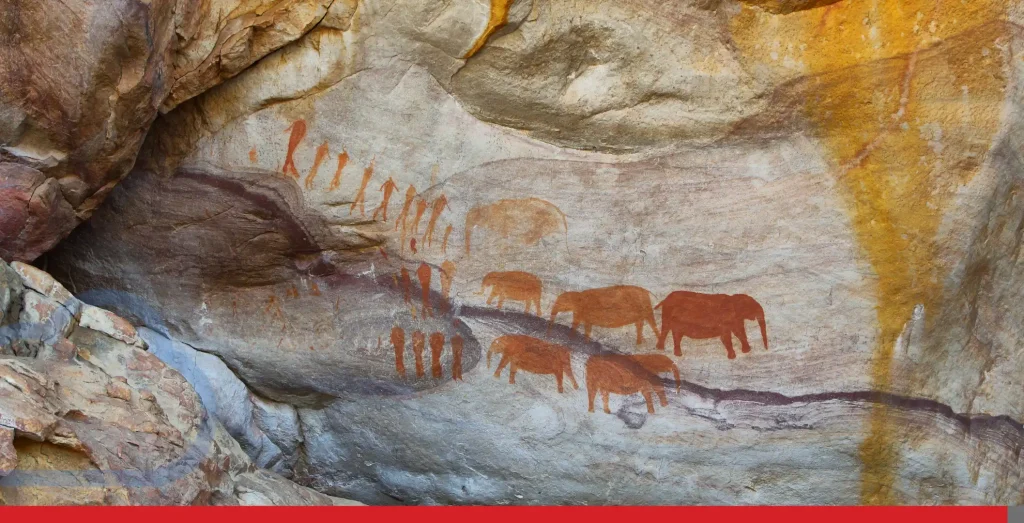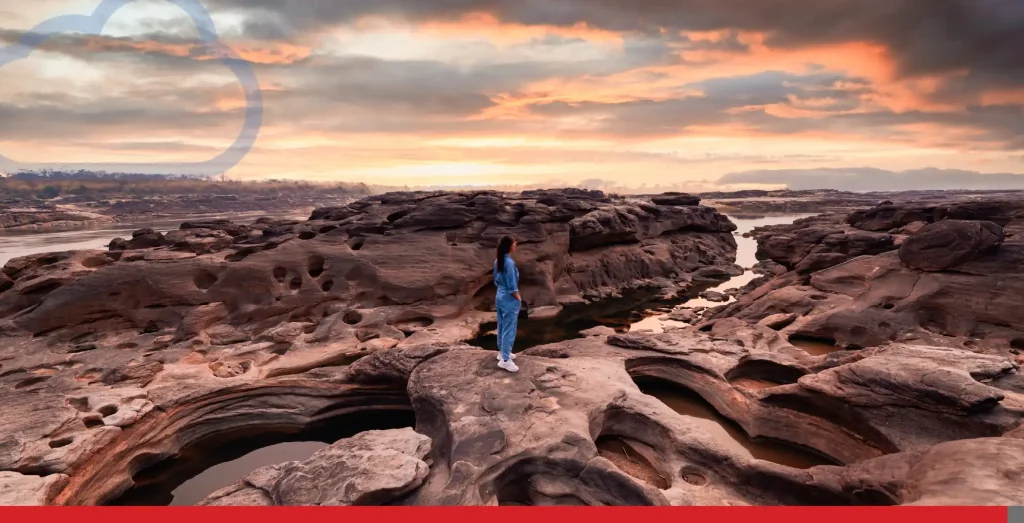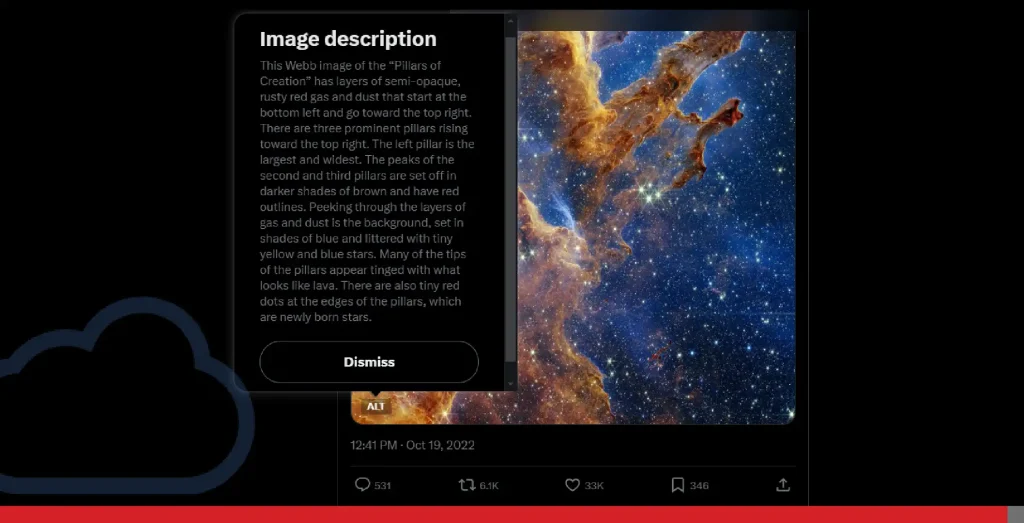“A picture is worth a thousand words.” This age-old adage rings truer than ever in today’s digital landscape. In a world bombarded with information, visual content has become the undisputed king. It captures attention and drives engagement like never before.
Did you know that the human brain processes an image 60,000 times faster than text? This staggering number underlines the power of visuals to cut through the noise and make a lasting impression on the viewer.
This blog explores the many advantages of producing captivating visual content while equipping you with the insights and tactics necessary to leverage its potential. You can use the information in our blog to amplify your content marketing strategies and learn how to give valuable information to your customers.
- History of Visuals: From Cave Paintings to Cat Memes
- The Foundation of Creating Engaging Visuals: Know Your Audience
- How Powerful Is Visual Content Marketing & Why Does It Matter?
- Seven Types of Engaging Visual Content: Choose Your Weapon!
- Design Principles for Captivating Visuals: Creating Impact
- Creating Engaging Visual Content: Best Practices
- Optimizing Visual Content for Social Media Platforms: Platform-Specific Strategies
- Visual Content Creation Tools & Resources: Streamlining Your Workflow
- Accessibility & Inclusion in Visual Content: Reaching Everyone
- Measuring Visual Content Success: Tracking Your Progress

History of Visuals: From Cave Paintings to Cat Memes
There was a time, believe it or not, when words were everything. Literally the only thing! But as time moved on, illuminated manuscripts became the original picture books. They were beautifully illustrated texts that helped people understand and engage with stories.
As technology advanced, so did visual sophistication. Photography became more widespread, graphic design emerged as a distinct field, and the world became increasingly visual.
Magazines, posters, and advertising all embraced the power of images to persuade, inform, and entertain. Data visualizations, such as charts and graphs, have become required tools for simplifying complex data and augmenting engagement in content.
And then, the internet happened! Suddenly, visuals were no longer just a supplement to text, but they became a driving force. Memes, GIFs, and viral videos exploded onto the scene, radically changing the way we communicate and consume information.
Now, you can make a whole conversation using images such as GIFs and memes. This development is remarkable, interesting, and weird all at the same time.
In the context of your blog, website or anything in between—visuals are the secret weapon for making your content pop, engage, and convert.

The Foundation of Creating Engaging Visuals: Know Your Audience
Before diving into the creation of visual content, it’s paramount to know who your audience is.
Creating visuals without a deep understanding of your target demographic is like designing a website for Gen Z using Comic Sans and animated GIFs. It won’t work, but it’ll surely become a meme.
You could create something visually stunning, but if it doesn’t resonate with your audience’s needs, interests, and preferences—it will fall flat.
Including relevant images boosts user engagement and conversion rates. Research shows that content with relevant images attracts more views and engagement compared to content without visuals. This fact illustrates the importance of appropriate imagery in marketing efforts.
What’s the best approach? Here are our suggestions.
- Demographics, interests, and pain points: Go beyond basic demographics like age and location. What are the audience’s aspirations? What are their daily challenges? What keeps them up at night? Understanding their motivations and pain points will help you create visuals that speak directly to their needs.
- Online behaviour and platform preferences: Where does the audience spend their time online? Are they active on Instagram, LinkedIn, or TikTok? What types of content do they engage with most? Understanding their online behaviour will help you tailor your visuals to the platforms they use and the formats they prefer.
- Creating buyer personas: Buyer personas are fictional representations of your ideal customers. They provide a concrete picture of who you’re trying to reach, their goals, and their challenges. Creating detailed buyer personas will guide your visual content creation process while ensuring that your visuals are targeted and powerful.
- Using data and AI: Leverage data and AI tools to gain deeper insights into your target audience. You can acquire valuable data on demographics, interests, and online behaviour by using Google Analytics, social media analytics platforms, and market research tools. AI-powered tools can help you analyze this data and identify patterns and trends.

How Powerful Is Visual Content Marketing & Why Does It Matter?
Visual content marketing is no longer a luxury but a necessity in modern marketing strategies. In a world saturated with information, visuals cut through the noise and capture attention in a way that text alone cannot.
But just how powerful is visual content marketing these days? Let’s find out below:
- Enhanced engagement and brand recall: Visuals are processed by the brain much faster than text. They grab attention, spark your audience’s emotions, and sharpen their memory. Engaging visuals help your audience remember your brand and your message long after they’ve seen your content.
- Increased website traffic and SEO: Streamlined visuals can polish your website’s SEO. Use descriptive alt text for images, while adjusting file names and ensuring your visuals are mobile-friendly. This will help search engines understand your content and upgrade your website’s ranking.
- Boosting conversions and ROI: Visual content can directly impact your bottom line. Compelling visuals can drive traffic to your website, increase engagement, and give higher conversion rates. Use visuals to showcase your products or services, tell your brand story, and create a connection with your audience. Studies show that websites with images get 94% more views than those without.
- Competitive advantage: In a crowded marketplace, strong visuals can differentiate your brand from the competition. Invest in high-quality visuals that reflect your brand’s personality and values. This technique will help you stand out and make a lasting impression on your audience.
In short, visual content marketing matters because it’s the most effective way to:
- Capture attention.
- Communicate your message.
- Achieve your marketing goals in the digital age.
It’s not just about aesthetics; it’s about driving real business results.
You can visit us at www.easyhosting.com to learn more about our web hosting options for businesses and individuals.
You can also send an email to support@easyhosting.com or even call us at 1-888-390-1210!

Seven Types of Engaging Visual Content: Choose Your Weapon!
The world of visual content is a giant box of crayons, ready to help you dress your projects with various types of visual content. Choosing the right crayon is like selecting the perfect tool for the job—it can make all the difference. Here’s a breakdown of some powerful visual content weapons you can add to your arsenal:
- Images: High-quality photography, illustrations, and graphics are indispensable for creating visually appealing content. Use images that are relevant to your message and copy. Make the images visually compelling and tailor-made for the platform you’re using.
- Videos: Videos are incredibly engaging and can be used to tell stories, showcase products, and connect with your audience on a deeper level. Short-form videos, explainer videos, and behind-the-scenes glimpses can all be successful. Viewers retain 95% of a message when they watch it in a video compared to 10% when reading it in text.
- Infographics: Infographics are a great way to present complex information in a visually appealing and easy-to-understand format. Use infographics to share data, statistics, and key takeaways.
- Memes and GIFs: Memes and GIFs can add humour and personality to your marketing content, particularly when targeting a younger audience. Use them sparingly and ensure they are relevant to your brand and your message.
- Presentations: Presentations are ideal for sharing information in a structured and visually engaging format. Use presentations for webinars, conferences, and internal communications.
- Interactive content: Interactive content, such as quizzes, polls, and 360° videos, encourages audience participation and creates a more engaging experience.
- User-generated content (UGC): UGC is authentic content created by your customers. Sharing UGC can build trust and social proof, showcasing real experiences with your brand.
Design Principles for Captivating Visuals: Creating Impact
Strong visual content is more than just pretty pictures. It’s about applying design principles to create visuals that are both aesthetically pleasing and strategically productive.
Original images, such as screenshots or infographics that explain your content, are crucial for creating authentic and engaging visuals that strengthen content engagement and brand identity.
- Colour psychology: Colours evoke emotions. Understanding the psychology of colour can help you choose colours that align with your brand and your message.
- Typography: Font choices play a deciding factor in readability and visual appeal. Choose fonts that are easy to read and reflect your brand’s personality.
- Layout and composition: The layout and composition of your visuals determine how your audience perceives your message. Create a cohesive design to guide the viewer’s eye by using visual hierarchy, balance, and flow.
- Brand consistency: Maintaining a consistent visual identity across your marketing channels is essential for building brand recognition and trust.
- Visual storytelling: Crafting narratives with visuals can make your content more engaging and memorable. Use visuals to tell your brand story, connect with your audience on an emotional level, and create a lasting impact.
Creating Engaging Visual Content: Best Practices
Creating engaging visual content is a process that requires careful planning and execution.
- Standing out on social media: Social media platforms are visually driven. Create visuals that are tailor-made to each platform’s specific requirements and best practices.
- Incorporating text effectively: Text can be a valuable addition to your visuals, providing context and reinforcing your message. Use captions, overlays, and subtitles to communicate information.
- Adding interactive elements: Interactive elements can make your visuals more engaging and encourage audience participation.
- Accessibility considerations: Ensure your visuals are accessible to everyone, including people with disabilities. Use alt text for images and captions for videos, while ensuring sufficient colour contrast.
Optimizing Visual Content for Social Media Platforms: Platform-Specific Strategies
Each social media platform has its own unique characteristics and best practices for visual content.
Social media posts play a role in supplementing accessibility and engagement. Brands like Gucci and NASA have improved their content by adhering to accessibility guidelines. These guidelines—which include adding alt text and ensuring visual consistency—not only enrich the user experience but also boost interaction and conversion rates.

- Image and video sizes: Alter your visuals to the correct dimensions for each platform while avoiding cropping and distortion.
- Content formats: Utilize the content formats that are the most helpful on each platform, such as Reels on Instagram or Facebook Carousels.
- Hashtags and keywords: Use relevant hashtags and keywords to increase the discoverability of your visual content.
- Social media analytics: Track your social media metrics to see what’s working and what’s not. Use this data to adjust your visual content strategy accordingly.
Visual Content Creation Tools & Resources: Streamlining Your Workflow
Numerous tools and resources are available to help you create high-quality visual content.
- Graphic design tools: Canva, Adobe Photoshop, and Adobe Illustrator.
- Video editing tools: Adobe Premiere Pro, Final Cut Pro, and DaVinci Resolve.
- Stock photo and video websites: Unsplash, Pexels, and Shutterstock.
- AI-powered tools that can generate images from text descriptions: DALL-E 2 and Midjourney.
Also, creating YouTube videos can significantly boost your content marketing strategy. Tools like TubeBuddy and VidIQ can help you hone your videos for better engagement and visibility.
Accessibility & Inclusion in Visual Content: Reaching Everyone
Accessibility is not only a best practice but a responsibility. Ensure your visual content is accessible to everyone, regardless of their abilities.
To inspire brands to up their social media presence, consider curated visual content examples such as infographics, accessible image galleries, and videos with clear subtitles.
- Alt text for images: Alt text describes the image to screen readers, making it accessible to visually impaired users. It also helps search engines understand the content of your images.
- Captions and subtitles for videos: Captions and subtitles make videos accessible to viewers who are hard of hearing while making comprehension better for viewers in noisy environments.
- Colour contrast: Ensure sufficient colour contrast between text and background to make it readable for people with low vision.
- Accessible fonts and typography: Choose fonts that are easy to read and avoid decorative or overly stylized fonts.
- Descriptive audio for videos: Provide audio descriptions of visual elements for visually impaired viewers.

Measuring Visual Content Success: Tracking Your Progress
Creating stunning visuals is only half the battle. The real value lies in understanding how your visuals are performing and using data to refine your marketing strategy.
Without tracking and analysis, you’re creating content in a vacuum. The saying, “What gets measured gets managed,” holds especially true for visual content marketing.
- Key performance indicators (KPIs): Identify the metrics that align with your business goals. Are you trying to increase brand awareness, drive website traffic, or boost conversions? Your KPIs will guide your tracking and analysis efforts.
- Website traffic and engagement: Use Google Analytics to track website traffic originating from your visual content. Monitor metrics like page views, time on page, bounce rate, and click-through rates.
- Social media metrics: Track engagement metrics on social media platforms, such as likes, shares, comments, impressions, and reach. Use platform-specific analytics tools to gain insights into how your visuals are performing.
- Conversion rates: If your goal is to drive conversions, track how your visual content is contributing to sales, leads, or sign-ups. Use UTM parameters to track the source of your conversions.
- A/B testing: Experiment with different versions of your visuals to see which ones perform best. A/B testing allows you to make data-driven decisions about your visual content strategy.
- Tools for analysis: Leverage analytics platforms like Google Analytics, social media analytics dashboards, and marketing automation tools to track and analyze your visual content performance.
Conclusion
A robust content marketing strategy that includes engaging visual content is not a nice to have but a must-have for any business looking to thrive in the digital age. By getting to know your audience, applying design principles, and staying up-to-date with trends, you can create visuals that capture attention, evoke emotions, and drive meaningful results.
Invest in your visual content strategy, and you’ll reap the rewards of increased engagement, brand awareness, and conversions. Start creating engaging visuals today and unlock the full potential of your marketing efforts.
FREQUENTLY ASKED QUESTIONS
How much should I invest in visual content creation?
The investment depends on your budget, goals, and industry. Start by allocating a portion of your marketing budget to visual content creation and track your ROI.
How often should I update my visual content?
Regularly updating your visual content is important for staying relevant and engaging your audience. Aim to refresh your visuals at least quarterly or more frequently if needed.
What are some common mistakes to avoid when creating visual content?
Some common mistakes include using low-quality images, neglecting accessibility, ignoring brand consistency, and failing to track performance.
How can I repurpose my visual content?
You can repurpose your visual content by sharing it on different platforms, creating infographics from blog posts, turning videos into GIFs, and using quotes as social media graphics.
How can I measure the ROI of my visual content marketing efforts?
Track principal metrics like:
- Website traffic
- Social media engagement
- Lead generation
- Sales conversions conversions
Also, use analytics tools to measure the impact of your visual content on these metrics. Calculate the cost of your visual content creation and compare it to the revenue generated to determine your ROI.
Where can I find inspiration for my visual content?
Look at what your competitors are doing, explore design blogs and websites, and follow visual content creators on social media. Use tools like Pinterest and Dribbble to discover new ideas.
Do I need professional design skills to create engaging visuals?
While professional design skills are beneficial, many user-friendly tools like Canva allow you to create high-quality visuals even without design experience.
How important is mobile optimization for visual content?
Mobile optimization is everything. Ensure your visuals are responsive and display correctly on all devices, especially smartphones. A large percentage of internet users access content via mobile devices.
What is the ideal length for a marketing video?
The ideal length depends on the platform and the content. Short-form videos (under 60 seconds) are generally preferred for social media. In contrast, longer videos may be more suited to YouTube or your website. Keep viewers engaged by quickly delivering value.
How can I encourage user-generated content (UGC)?
Run contests or giveaways, create branded hashtags, feature user content on your social media channels, and offer incentives for sharing. Make it easy and rewarding for customers to create while sharing content related to your brand.



